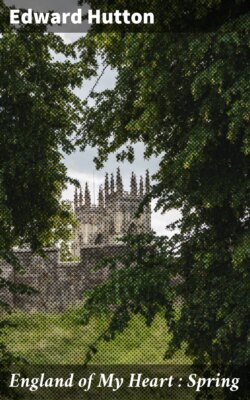Читать книгу England of My Heart : Spring - Edward Hutton - Страница 6
На сайте Литреса книга снята с продажи.
Оглавление| For we turn to gaze on London, the Protestant, not the Catholic, city: A mighty mass of brick and smoke and shipping, Dirty and dusky, but as wide as eye Could reach, with here and there a sail just skipping In sight, then lost amid the forestry Of masts; a wilderness of steeples peeping On tiptoe through their sea-coal canopy; A huge dun cupola like a foolscap crown On a fool's head—and there is London town! Don Juan had got out on Shooters' Hill Sunset the time, the place the same declivity Which looks along that vale of good and ill Where London streets ferment in full activity; While everything around was calm and still Except the creak of wheels which on their pivot he Heard—and that bee-like, babbling, busy hum Of cities, that boil over with their scum. |
The prospect eastward across the broad valley of the Darent, if less wonderful, is assuredly far lovelier than that north-westward over London; but from the top of Shooters' Hill we probably do not follow the actual route of the ancient way until we come to Welling. The present road down the hill eastward is said to date from 1739 only. [Footnote: See H. Littlehales, "Some Notes on the Road from Canterbury in the Middle Ages" (Chaucer Society, 1898).]
There is nothing to keep us in Welling, nor indeed in Bexley Heath, except to note that they are the first two Kentish villages upon our route, now little more than suburban places spoiled of any virtue they may have possessed. It is said that at Clapton Villa in the latter place there is preserved "an ancient and perfect sacramental wafer"—perhaps an unique treasure.
The road runs straight on through a rather sophisticated countryside, almost into Crayford, but in preparing to cross the Cray the old road has apparently been lost. We may be sure, however, of not straying more than a few yards out of the way, if we keep as straight on as maybe, that is to say, if we take the road to the right at the fork, which later passes Crayford church on the south.
Crayford, though it be anything but picturesque, is nevertheless not without interest. It is the Creccanford of the "Saxon Chronicle," and was the scene of the half-legendary final battle between the Britons here and Hengist, who utterly discomfited them, so that we read they forsook all this valley, even, so we are asked to believe, those strange caves which they are said to have burrowed in the chalk for their retreat, and which are so plentiful hereabouts, but which assuredly are infinitely older than the advent of the Saxon pirates.
The real interest of Crayford, however, as of more than one place in this valley, lies in its church. This is dedicated in honour of the companion of St. Augustine, St. Paulinus, who became the third Bishop of Rochester. The form of the church is curious, the arcade of the nave being in the midst of it, while the chancel, of about the same width as the nave, is possessed of two arcades and divided into three aisles; thus the arcade of the nave abuts upon the centre of the chancel arch. Parts of the church certainly date from Chaucer's day, but most of it is Perpendicular in style.
More interesting than Crayford itself are North Cray and Foot's Cray in the upper valley beyond Bexley. At North Cray there is one of the best pictures Sassoferrato ever painted, a Crucifixion, over the altar. At Foot's Cray, the church, besides being beautiful in its situation, possesses a great square Norman font.
These places are, however, off the Pilgrims' Road, which climbs up through Crayford High Street, and then in about two miles begins to descend into the very ancient town of Dartford, where it is said Chaucer's pilgrims slept, their first night on the road.
